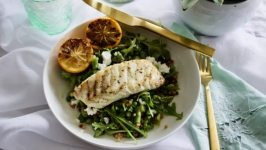Food Waste Finds a Home
Christopher Adkins is a chef with a mission. Every Wednesday evening, he can be found preparing fresh dinners for upwards of 200 attendees at St. Luke’s United Methodist Church in Indianapolis. But it’s the ingredients in those dinners that really get Adkins excited, and inspired the idea for Ingredient Trading Company (ITC)—a concept that supports his ultimate food mission: food preservation.
Adkins’ business idea is simple: ITC will be a conduit between restaurants and Indiana farmers and agriculturalists. Restaurants can purchase produce that typically goes unsold, and then use that to prepare dishes to serve as well as value-added products to sell, such as salsa, jam and pickled items.
“Farmers always have excess produce and it typically is turned into feed or compost,” says Adkins. “By buying excess produce at cost, local farmers can make money from their crops. At the same time, it reduces food waste.”
The idea of restaurants cooking with local produce is not new, but the idea of one distributor working with dozens of farmers and restaurants is a new business model for the Indianapolis food industry. While ITC is still in the developmental stages, Adkins is partially practicing this concept at St. Luke’s. Adkins was hired to create the Wednesday-night dinner served to members and guests of the congregation during its educational programs and classes.
Susan Farquey, director of the program ministries at St. Luke’s, believes this concept fits in nicely with the church’s mission. “We really want to provide a healthy meal that tastes great and supports local farmers,” she says. “We don’t want to buy all premade meals. We want to do what we can to make sure people live a healthy life.”
The challenge for restaurants is how to serve meals comprised of local ingredients in a cost-effective way. This is what Adkins, a chef and entrepreneur, is looking to do.
From chef to business owner
Adkins was raised in Lawrence Township. When he was 20 years old, he took a culinary class at Ivy Tech Community College and immediately wanted to learn more about cuisine.
He attended New England Culinary Institute for three years and was drawn to the curriculum that focused on sustainability. This is where Adkins developed a passion for preservation. “I love understanding preservation methods and extending the seasons,” he says.
After culinary school, Adkins interned at Michelin star-rated restaurants in Chicago and New York City. But he wanted to return to his Indiana roots and have an impact in the local economy. He worked as a line cook at Spoke & Steele, and a sous chef for Garden Table. It was during this time that Adkins began thinkingabout how shared agriculture can help restaurants and farmers. He realized his interests were more than simply cooking delicious food, but sustainability as well. “I want to make a difference,” he says. “That’s probably why I’ve always been on the fringe of this industry.”
So when the opportunity to be the chef at St. Luke’s presented itself, Adkins realized this was the occasion he was looking for to marry the desires to cook and practice sustainability. “Restaurants are often focused on preparing specific cuisine,” he says. “I believe there’s a balance and medium out there, and this job has given me the chance to do that.”
Future challenges and opportunities
Adkins hopes to have the business license by the end of 2017. He has already secured partnerships with Annabelle’s Gardens and Garcia’s Gardens, and is building awareness with other Indiana farmers. One of the challenges is illustrating to the farmers that selling unused produce to him at cost would be more beneficial than holding out for full-price purchase offers.
“Many farmers are hesitant to release their produce because they hope it will sell,” says Adkins. “But what many don’t realize is that if it doesn’t sell, it turns to waste. But by selling to me at a lower cost, they will still be compensated and the food won’t be wasted.” He also hopes to create a business where restaurateurs and chefs can make a livable wage, even when purchasing local ingredients rather than in bulk from larger and less expensive distributors. “I can’t name a chef with a great retirement plan,” he says. “These are people working 60 to 70 hours per week, providing a service to customers. I want to be doing this when I’m 50 and beyond. And I want to be healthy and happy about it.”
How you can practice sustainability and use overripe produce at home
Everyone has bought one too many bananas and let one turn just a bit too brown to eat on its own. Here are eight ways you can use overripe produce and eliminate waste in your own kitchen.
• Use tomatoes to create pasta sauce and freeze the finish product.
• Mash overripe bananas to create a quick banana bread or muffins.
• Boil your abundance of carrots, celery, onions, garlic and herbs with water to create vegetable stock.
• Cut up fruit and place in plastic bags or containers in the freezer for smoothie starter packets.
• Cut up extra fruit such as apples, strawberries, etc., and slowcook them to create jam.
• Chop up tomatoes, onions and garlic for fresh salsa.
• If you have too many lemons or limes, zest and squeeze the citrus. Zest can be used in future baked goods, and juice can be frozen for future meals.
• Infuse your water with cucumbers, lemons or berries you are not planning to eat.
Are you a producer with overripe or ugly produce that doesn’t make it to the market? ITC is interested in taking it off your hands.
Contact Christopher Adkins
charles.ingredient.trading.co@gmail.com
317.225.9725







